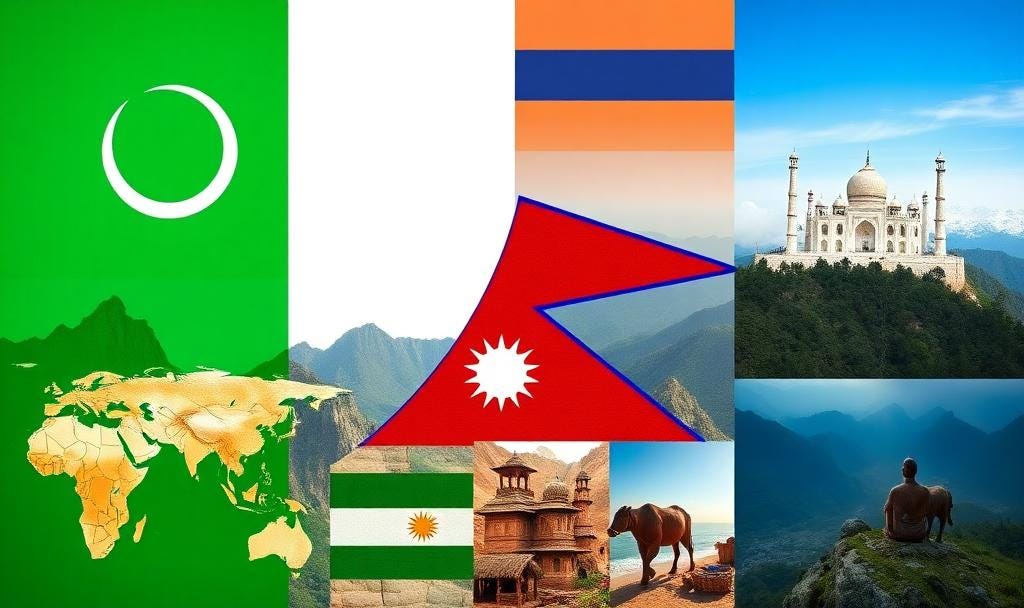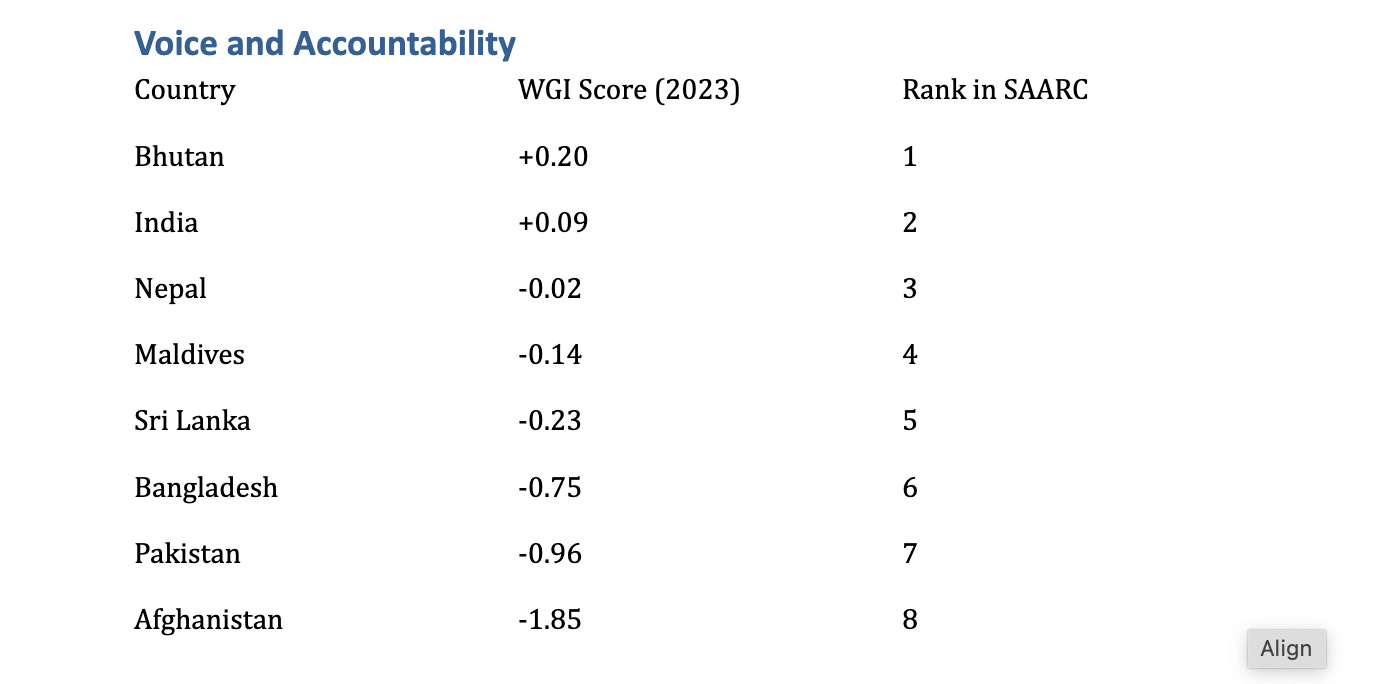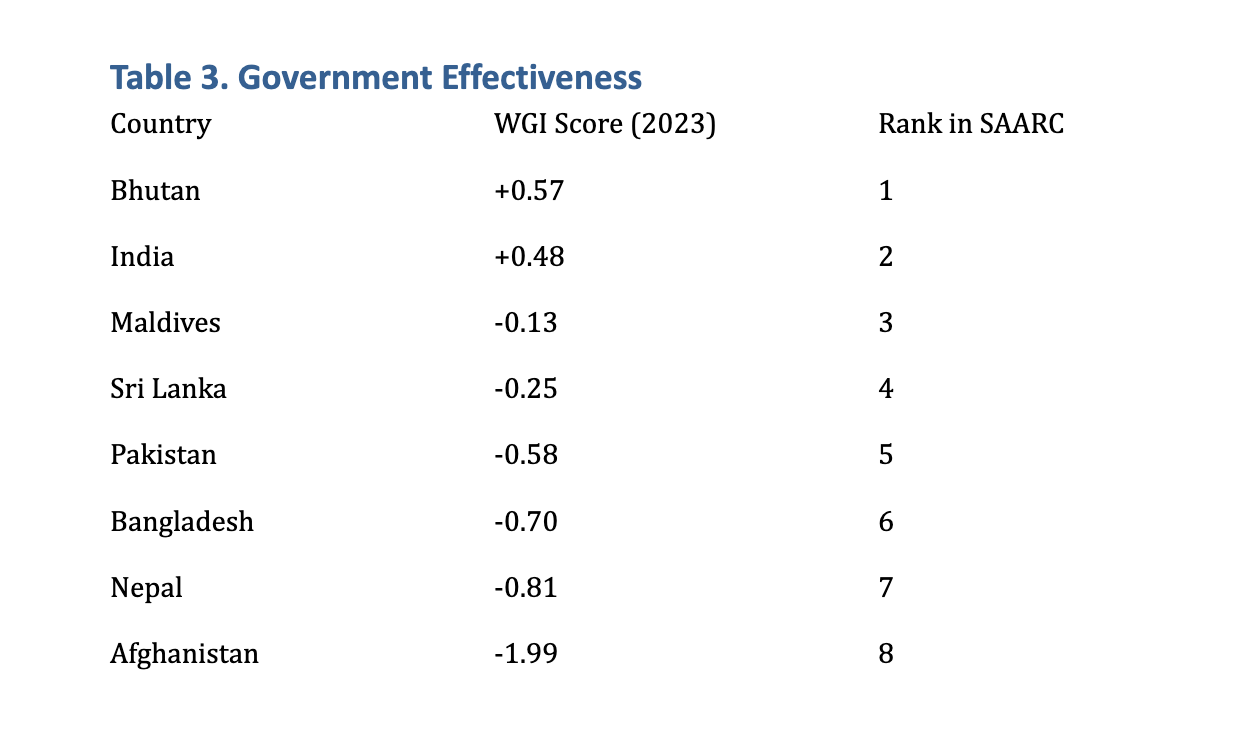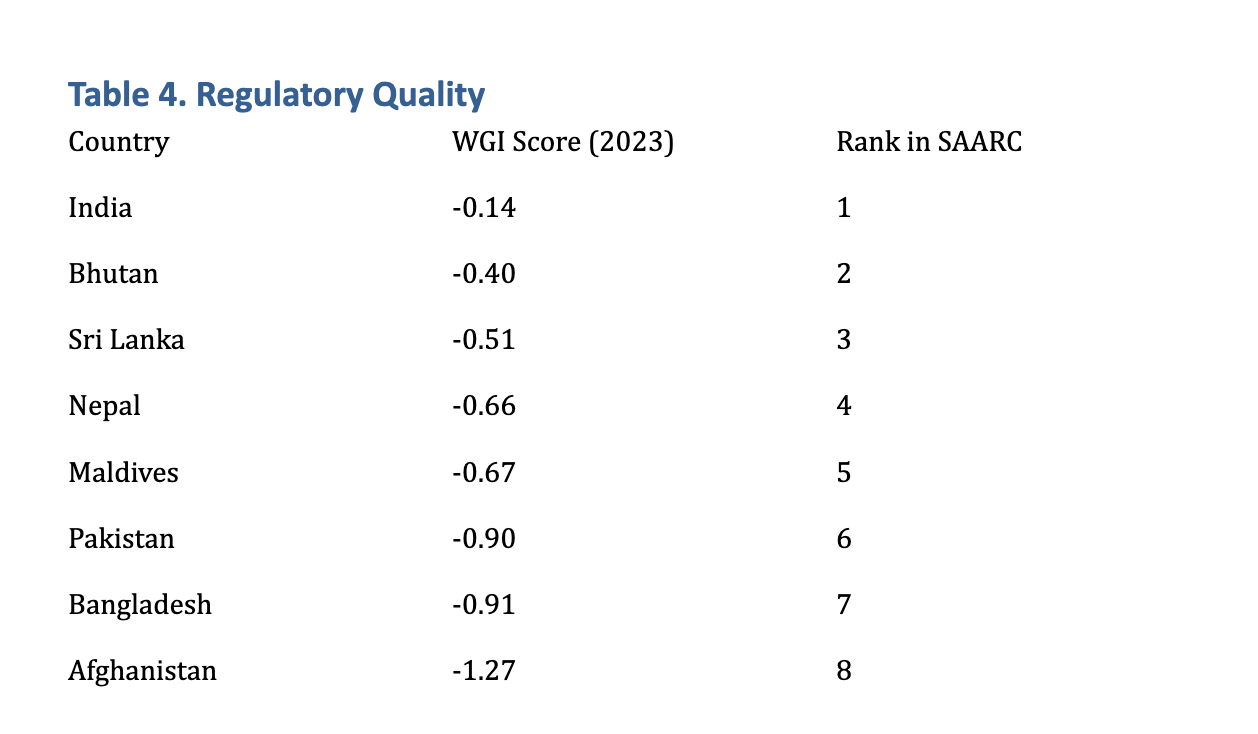Good Governance in SAARC Countries
Good governance is measured by the World Bank’s Worldwide Governance Indicators (WGI) across six broad dimensions. Below we compare the eight SAARC countries – Afghanistan, Bangladesh, Bhutan, India, Maldives, Nepal, Pakistan, and Sri Lanka – on each WGI dimension using the latest available data (2023). For each indicator, we provide country scores, rank the countries within SAARC, and highlight notable trends or outliers. All WGI scores range from -2.5 (weak governance) to +2.5 (strong governance).
Voice and Accountability (VA)
Voice and Accountability captures perceptions of citizens’ ability to participate in government selection, freedom of expression, freedom of association, and free media. Higher scores mean more democratic and free society. Table 1 compares SAARC countries on VA.
Observations: Bhutan leads with a positive score, indicating relatively strong democratic freedoms, whereas Afghanistan scores the lowest by far. In fact, Bhutan’s VA score was +0.20 in 2023, highest among SAARC, while Afghanistan’s was -1.85, the weakest (and among the lowest globally) ( Read theglobaleconomy.comtheglobaleconomy.com. Most other SAARC nations have negative VA scores, indicating deficits in democratic freedoms compared to the world average (around -0.03, Read theglobaleconomy.com). Nepal and India stand out with only slightly negative or even positive values, whereas Pakistan and Bangladesh score quite low.
Table 1. SAARC Comparasion on Voice and Accountability
2. Political Stability and Absence of Violence/Terrorism (PS)
Political Stability and Absence of Violence/Terrorism reflects the likelihood of political instability and politically-motivated violence (including terrorism). Higher scores mean a more stable, secure environment. Table 2 shows the SAARC comparison.
Observations: Bhutan and Maldives are notable outliers with positive stability scores – Bhutan scored +0.98 and Maldives +0.53 in 2023, ranking first and second in the region (Read theglobaleconomy.comtheglobaleconomy.com. These two enjoy relatively stable political environments. Nepal and Sri Lanka are mid-range with moderately negative scores (around -0.2 to -0.5), reflecting some instability. In contrast, Afghanistan (-2.48) and Pakistan (-1.93) have extremely low scores, indicating severe instability, conflict, or violence (Read theglobaleconomy.comtheglobaleconomy.com. Afghanistan’s score is the worst in SAARC (and among the bottom five worldwide), underscoring the ongoing conflict and governance challenges there. Bangladesh and India also score below zero, indicating notable instability or violence issues, though not as acute as Pakistan or Afghanistan.
Table 2. SAARC Comparasion on PS and Absence of Violence
3. Government Effectiveness (GE)
Government Effectiveness measures the quality of public services, civil service, policy formulation and implementation, and government credibility. Higher scores mean more effective governance. Table 3 provides the scores for SAARC countries.
Observations: Bhutan again tops the region with a Government Effectiveness score of +0.57( theglobaleconomy.com), reflecting comparatively efficient public administration. India is close behind (+0.48), also indicating moderately effective governance (theglobaleconomy.com. These two are the only SAARC countries with positive or near-positive GE scores. The Maldives and Sri Lanka score slightly negative (around -0.1 to -0.3), indicating average effectiveness with room for improvement. Bangladesh, Pakistan, and Nepal are in the lower-middle range (scores around -0.5 to -0.8), signaling significant challenges in government services and policy implementation. Afghanistan scores -1.99, the worst in SAARC(Resad theglobaleconomy.com), reflecting extremely poor government performance (near the global bottom). Notably, the gap between Bhutan/India and Afghanistan is very large, highlighting a major regional disparity in governance capacity ( Read theglobaleconomy.comtheglobaleconomy.com).
4. Regulatory Quality (RQ)
Regulatory Quality reflects the ability of the government to formulate and implement sound policies and regulations that permit and promote private sector development. Higher scores indicate more business-friendly and effective regulations. Table 4 compares SAARC countries on RQ.
Observations: India leads on Regulatory Quality with a score of -0.14, which, while slightly negative, is the best in SAARC. This suggests India’s regulatory environment is relatively more conducive to business and policy implementation than its neighbors. Bhutan (-0.40) and Sri Lanka (-0.51) follow, indicating moderate regulatory performance. Nepal and Maldives score around -0.66 to -0.67, reflecting weaker regulatory frameworks. Pakistan (-0.90) and Bangladesh (-0.91) are near the bottom regionally, pointing to significant regulatory and business climate challenges. Afghanistan’s RQ score is -1.27, the lowest in SAARC, highlighting extremely poor regulatory conditions, likely due to political turmoil and lack of stable institutions. Notably, all SAARC countries score below the world average on RQ, showing that regulatory quality is a general weakness across the region.
5. Rule of Law (RL)
Rule of Law measures perceptions of the extent to which agents have confidence in and abide by the rules of society, including the quality of contract enforcement, property rights, the police, courts, and likelihood of crime/violence. Higher scores indicate stronger rule of law. Table 5 shows SAARC performance.
Observations: Bhutan excels with a Rule of Law score of +0.67, by far the best in SAARCtheglobaleconomy.com. This suggests that Bhutan has comparatively strong legal institutions and order (indeed, Bhutan’s global rank on Rule of Law is 47/193, a notable achievementtheglobaleconomy.com). India is the second-best at +0.19, indicating a moderately positive rule-of-law environmenttheglobaleconomy.com. Maldives and Sri Lanka score just below zero (-0.08 and -0.09), implying relatively average legal governance (these two are very close, essentially tied for third in SAARC). Nepal (-0.46) and Bangladesh (-0.50) fall in the mid-low range, pointing to significant issues in legal enforcement and justice. Pakistan (-0.86) and Afghanistan (-1.65) are the weakest in the region on rule of lawtheglobaleconomy.com. Afghanistan’s extremely low score reflects the breakdown of formal legal institutions amid conflict. Overall, the spread is large: Bhutan’s strong rule of law versus Afghanistan’s very weak rule of law underscores a stark governance divide within SAARC.
6. Control of Corruption (CC)
Control of Corruption captures perceptions of corruption in government – lower corruption yields higher scores. Table 6 compares SAARC countries’ corruption control.
Observations: Bhutan is a remarkable outlier, with a Control of Corruption score of +1.53 in 2023theglobaleconomy.com. This score not only makes Bhutan the clear SAARC leader, but also places it among the top 20 countries globally for low corruption (rank 20/193). The next closest SAARC country is India at -0.37, which, despite being a negative score, ranks second in the region. Sri Lanka (-0.38), Maldives (-0.40), and Nepal (-0.51) cluster in the mid-range, indicating moderate corruption challenges. Bangladesh (-1.12) and Pakistan (-1.00) perform poorly, reflecting pervasive corruption issues in both the public and private sectors. Afghanistan’s score is -1.15 (Read theglobaleconomy.com, the worst in SAARC (and among the worst globally, on par with countries like Cameroon and worse than even some conflict states) (theglobaleconomy.com). The gap between Bhutan and the rest is the most striking here – Bhutan’s anti-corruption efforts and governance stand far above its neighbors. Conversely, Afghanistan, Pakistan, and Bangladesh show very high corruption levels, dragging down governance overall. This indicator exhibits the greatest internal disparity within SAARC.
In summary, Bhutan emerges as the top performer in governance among SAARC countries in 2023, whereas Afghanistan consistently ranks at the bottom in all dimensions. Other countries like India, Maldives, and Sri Lanka have pockets of relative strength but also significant governance deficits. Nepal, Bangladesh, and Pakistan show chronically weak performance in multiple areas. The data underline a substantial governance gap within South Asia – with Bhutan (and to an extent India) approaching global averages on many indicators, while others, especially Afghanistan, lag far behind . Improving governance across these dimensions remains a critical challenge for the SAARC region going forward.








